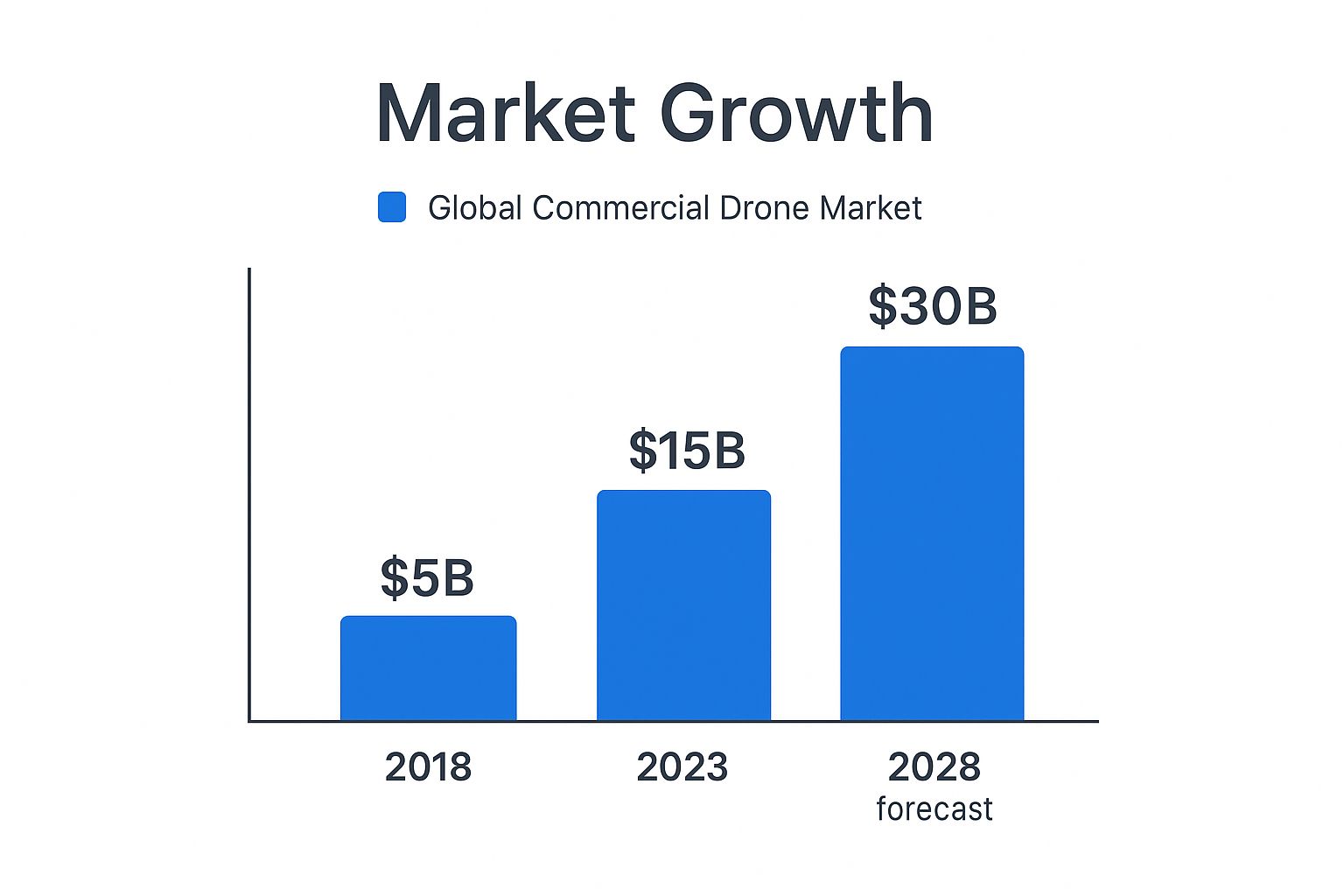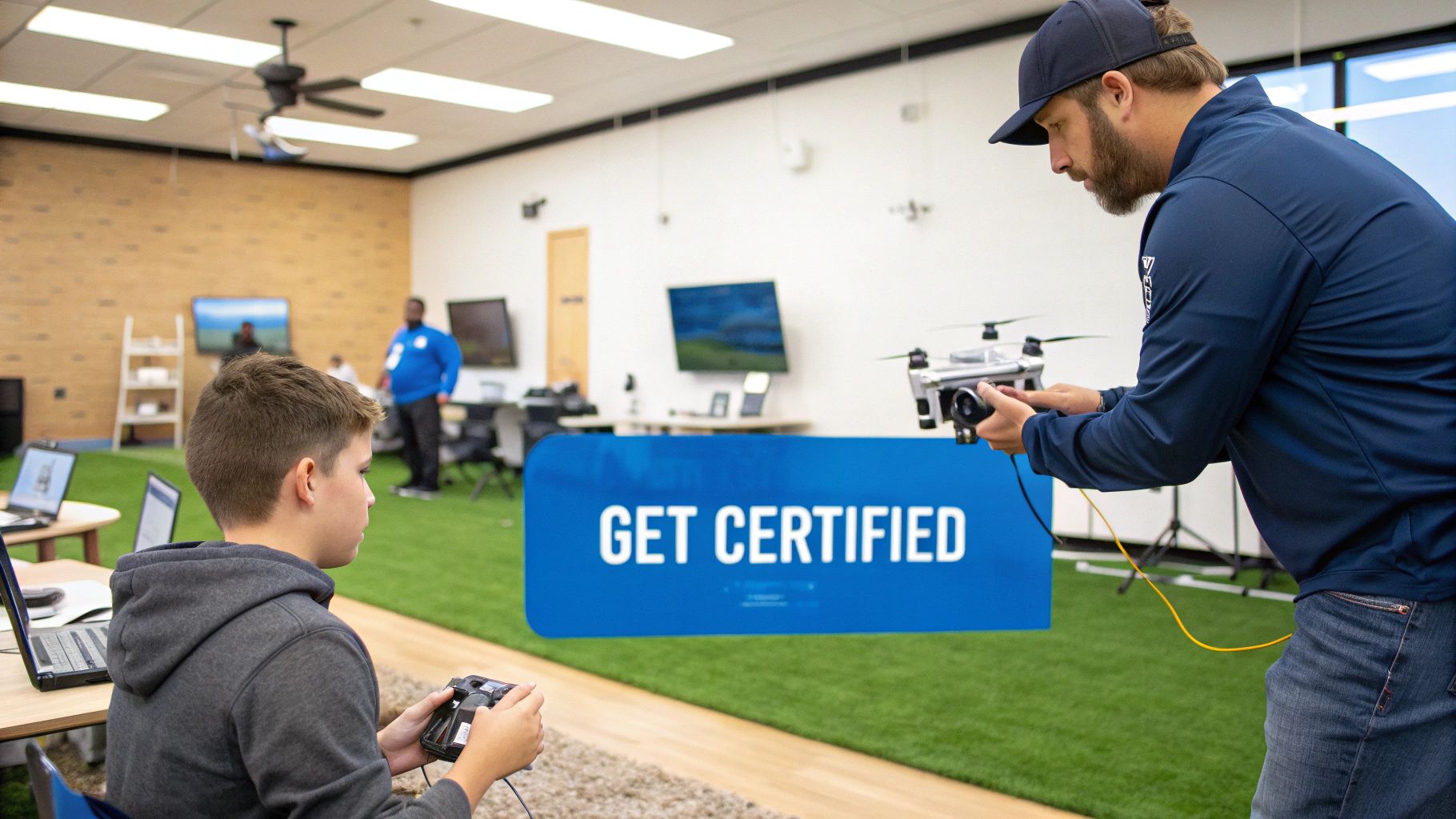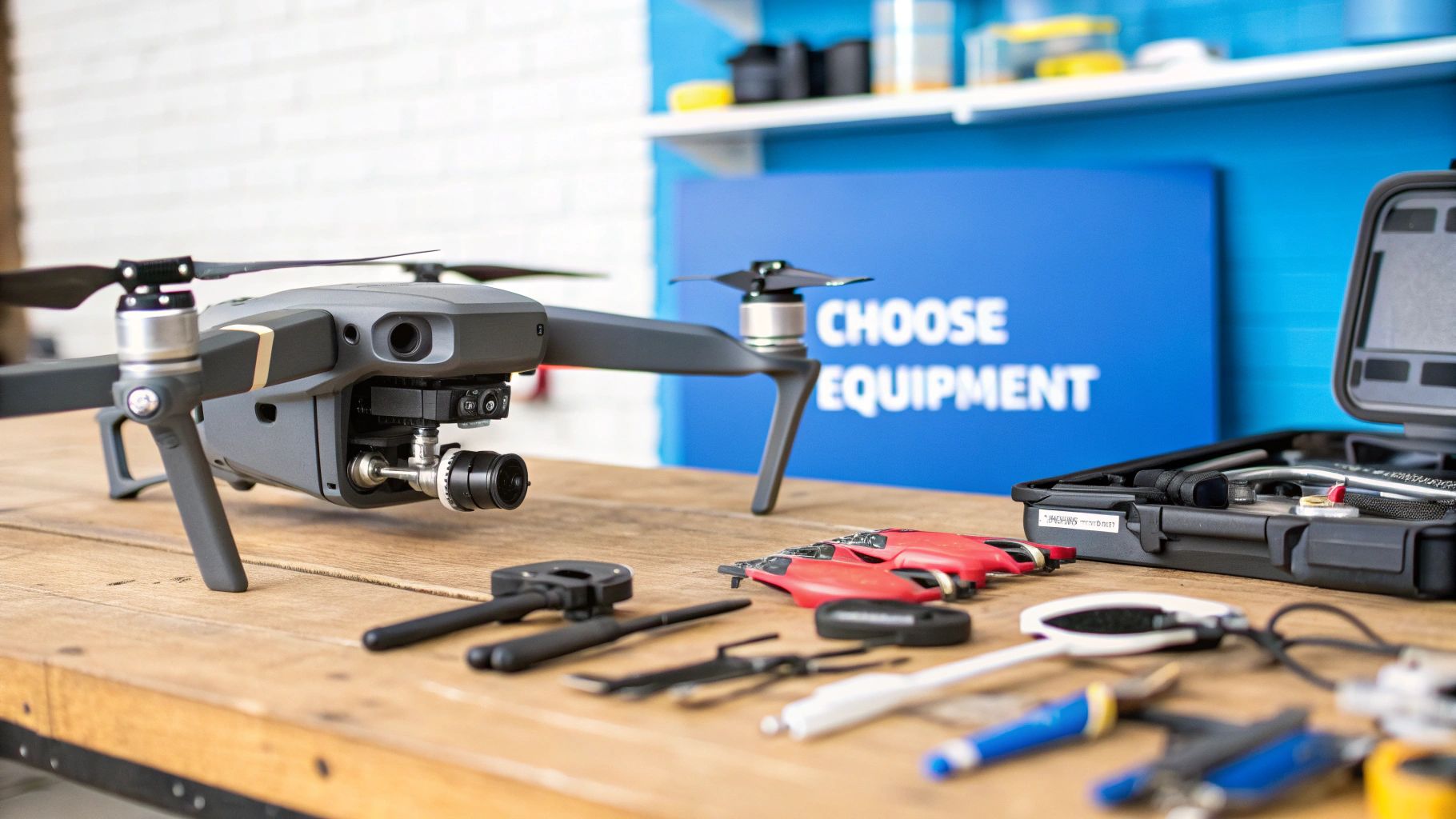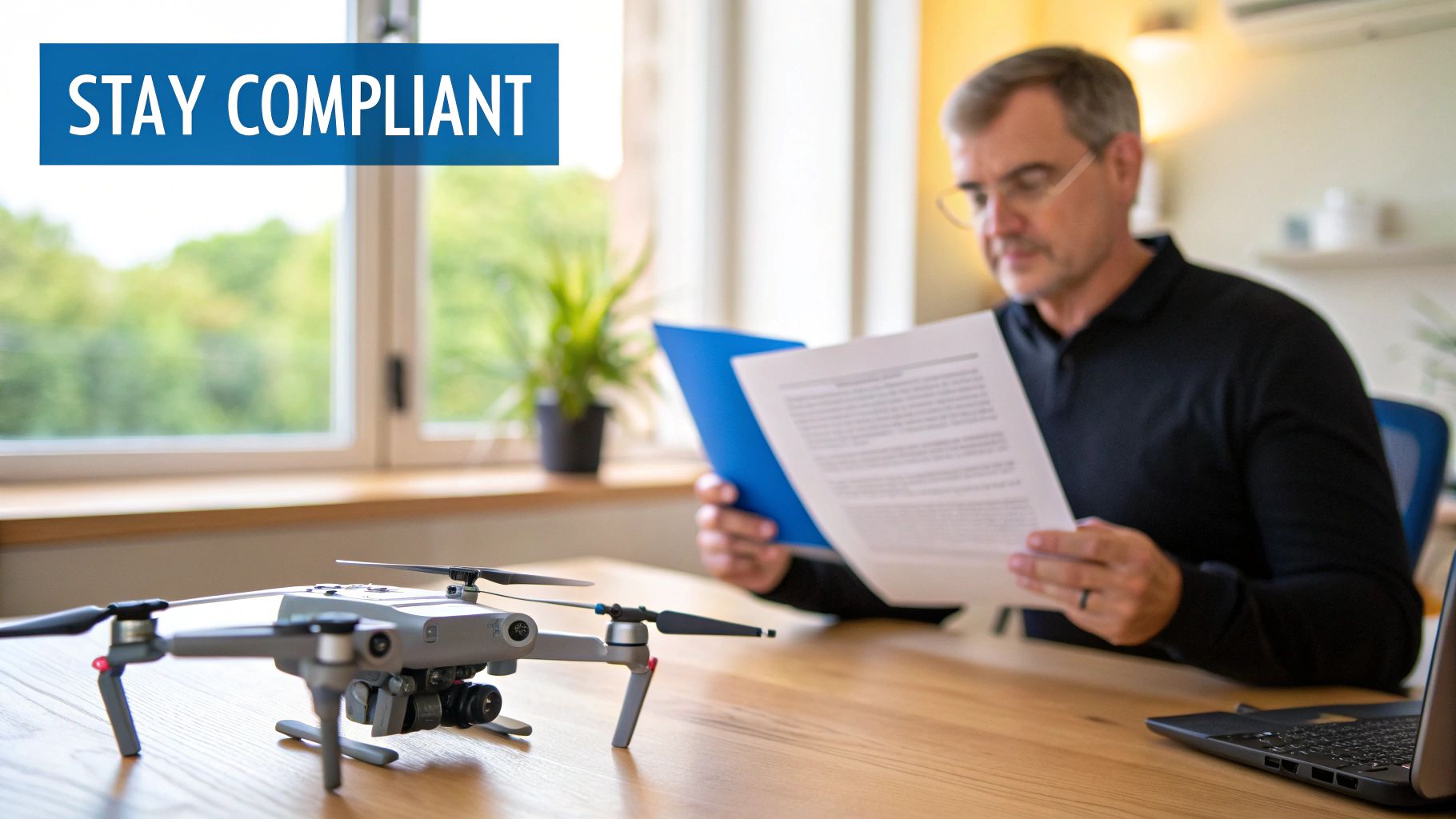How to Become a Commercial Drone Pilot: Your Guide
- Paul Simmons
- May 12
- 15 min read
Updated: May 13
Navigating the Commercial Drone Landscape
The drone industry is booming, presenting exciting career opportunities for aspiring commercial drone pilots. However, rapid growth also brings complexity. Understanding the current market and pinpointing promising areas is key to success. This involves looking beyond the hype and focusing on where the real demand is. For instance, advancements in drone technology constantly create new opportunities in sectors like construction, agriculture, and emergency services. These emerging areas offer exciting possibilities for pilots who position themselves strategically.

The infographic above illustrates the impressive projected growth of the global commercial drone market. From $5 billion in 2018, the market tripled to $15 billion in 2023 and is expected to double again to $30 billion by 2028. This explosive growth highlights the increasing demand for skilled commercial drone pilots. Grasping these market trends is vital for anyone considering this career path.
Understanding the growing demand for commercial drones is crucial for aspiring pilots. As of April 2025, over 1 million drones are registered with the FAA, including 383,007 commercial drone registrations in the United States. The commercial drone market is experiencing significant growth, with North America leading the charge, representing roughly 40% of the global market.
This region is propelled by an anticipated compound annual growth rate (CAGR) of 19.5% between 2021 and 2028. The United States maintains a dominant position within North America, boasting a market share exceeding 85%. This strong growth indicates a substantial need for skilled commercial drone pilots who can manage the expanding applications of drone technology. Find more detailed statistics here: FAA Drone Registration Data.
Key Opportunities in the Commercial Drone Sector
Several industries are witnessing a surge in drone adoption, creating diverse opportunities for skilled pilots. This expansion forges exciting career paths for those who recognize the potential and acquire the necessary skills. Let's explore some key sectors and the specialized skills they require:
Construction: Drones are reshaping construction sites by providing aerial surveys, progress monitoring, and 3D modeling. This application requires pilots skilled in photogrammetry and data analysis.
Agriculture: Precision agriculture is being revolutionized by drones that monitor crop health, assess irrigation needs, and apply targeted treatments. Pilots in this sector need expertise in specialized sensors and agricultural practices.
Emergency Services: Drones are essential tools for search and rescue, disaster assessment, and firefighting. This demands pilots with exceptional flight skills and adaptability in high-pressure situations.
To further illustrate the growing demand and specialized skillsets required, let's examine the following table:
Commercial Drone Applications Across Industries
Industry | Common Applications | Specialized Skills Required | Growth Potential |
|---|---|---|---|
Construction | Aerial surveys, progress monitoring, 3D modeling | Photogrammetry, data analysis, software proficiency (e.g., Autodesk ReCap), blueprint interpretation | High |
Agriculture | Crop health monitoring, irrigation assessment, targeted treatments | Multispectral sensor operation, data interpretation, knowledge of agricultural practices, software proficiency (e.g., DroneDeploy) | High |
Emergency Services | Search and rescue, disaster assessment, firefighting, thermal imaging | Exceptional flight skills, adaptability in high-pressure situations, thermal camera operation, FAA certifications | Moderate |
This table summarizes the key applications and required skills for drone pilots across various industries, highlighting the diverse opportunities and growth potential within the commercial drone sector.
Overcoming Misconceptions and Pitfalls
While the opportunities are abundant, it's important to avoid common pitfalls. Many aspiring pilots succumb to misconceptions that can hinder their progress. One such misconception is that expensive equipment guarantees success. In reality, focusing on specific client needs and developing the right skills are far more crucial.
Additionally, some pilots underestimate the importance of staying current with evolving regulations. This can lead to legal complications and stalled careers. By understanding the challenges and focusing on continuous learning, aspiring pilots can successfully navigate the commercial drone landscape and build a thriving career.
Mastering the Part 107 Certification Process

The Part 107 exam is your gateway to becoming a commercial drone pilot. This crucial step demands dedicated preparation and a strong understanding of key concepts. But with the right approach, success is within your reach. This section breaks down the certification process, offering valuable insights to help you on your journey. To legally operate a drone for commercial purposes, you'll need the FAA Part 107 Drone License.
Understanding the Certification Process
The Part 107 certification process involves several key steps. It begins with understanding the exam requirements, including airspace regulations, weather interpretation, and safe flight practices. This foundational knowledge is essential for both passing the exam and operating safely.
Familiarization with the FAA's regulations is also critical. This means understanding the specific rules for commercial drone operations, including limitations on flight locations and altitudes. Mastering these regulations is a cornerstone of responsible drone piloting. For more information, check out this resource on how to master drone regulations.
Effective Study Strategies
Passing the Part 107 exam demands effective study habits and choosing the right resources. Simply skimming the material isn't enough; you need a deep understanding of the concepts. This involves active learning, like taking practice tests and consistently reviewing key information.
The right study materials can make all the difference. While many resources exist, they're not all equal. Some emphasize memorization, while others focus on understanding the underlying principles. The latter approach leads to better retention and a more comprehensive grasp of the material. To help you choose, let's take a look at a comparison of different study resources:
To help you select the right study materials, we've compiled a comparison table:
Part 107 Exam Preparation Resources Comparison
Comprehensive comparison of study materials, online courses, and practice tests to help prepare for the Part 107 certification exam
Resource | Format | Cost | Topics Covered | User Ratings | Best For |
|---|---|---|---|---|---|
Remote Pilot 107 | Online Course | $297 (as of 2023-11-07) | Airspace, Regulations, Meteorology, Loading and Performance | 4.9 Stars | Visual Learners |
Online Course | $299 (as of 2023-11-07) | FAA Regulations, Airspace, Weather, Operations | 4.8 Stars | Interactive Learning | |
Part 107 Study Guide | Book | Varies | Comprehensive Part 107 topics | Varies | Self-Study |
FAA Part 107 Practice Test | Online Practice Tests | Free (Limited), Paid (Full Access) | All Exam Topics | 4.7 Stars | Exam Preparation |
This table highlights several popular resources, including online courses, study guides, and practice tests, comparing their formats, costs, and user ratings. Consider your learning style and budget when making your choice.
Tackling Challenging Concepts
Some Part 107 concepts can be challenging. Airspace classifications, for instance, can be complex and require focused study. Understanding the various airspace classes and their associated rules is vital for safe operations.
Weather interpretation is another area where many struggle. This involves understanding meteorological reports and how weather impacts drone flight. Mastering this is key for making informed decisions about flight safety.
Maintaining Compliance After Certification
Earning your Part 107 certificate is just the beginning. Remaining compliant with evolving regulations requires ongoing effort. This means staying updated on regulatory changes and completing any required recurrent training.
Effective recertification planning is also essential. This means understanding the recertification requirements and scheduling the necessary training in advance. Prioritizing continuous learning and compliance will ensure a successful career as a commercial drone pilot.
Resources for Success
Many valuable resources can help you prepare for the exam and stay informed about industry updates. These include online courses, study guides, and practice exams. Choosing resources that fit your learning style is key.
Connecting with the drone community is also beneficial. Online forums and communities provide platforms to connect with other pilots, share experiences, and stay up-to-date on industry developments.
Building Your Drone Arsenal: Equipment and Technical Mastery
Obtaining your Part 107 license is a significant step, but it’s just the beginning. Your success as a commercial drone pilot depends heavily on the equipment you choose and your technical proficiency. This section explores what truly matters for professional drone operations. You might be interested in: Drone Categories.
Choosing the Right Drone for the Job
Many new pilots make the mistake of focusing on the newest models and highest prices. However, experienced professionals know that selecting the right drone for the client's specific needs is much more important. For instance, a drone perfect for aerial photography may not be suitable for industrial inspections. Understanding the advantages and disadvantages of different drone types is key.
Different jobs require different tools. A small, nimble drone might be ideal for navigating tight spaces on a construction site. Meanwhile, a larger drone with a higher payload capacity might be necessary for agricultural spraying. Also, consider factors like battery life, range, and camera capabilities when choosing your drone.
Essential Drone Features for Commercial Operations
While attractive features can be tempting, some core features are essential for commercial drone pilots. Obstacle avoidance systems are vital for safe operations, particularly in complex environments. This technology helps prevent accidents, protecting your equipment and ensuring the safety of everyone nearby.
A high-quality camera is crucial for capturing professional photos and videos. This means understanding important specifications like resolution, sensor size, and dynamic range. But, a powerful camera is useless without a stable gimbal to keep your footage smooth. Investing in a dependable gimbal is essential for producing professional-looking results.
Developing Your Flight Skills
Technical expertise goes beyond understanding your equipment; it also involves improving your flight skills. Practicing in diverse environments and weather conditions builds confidence and prepares you for real-world situations. This practical experience is incredibly valuable.
Consider joining a local drone club or connecting with seasoned pilots for guidance. Learning from others and sharing best practices can significantly improve your skills. Mastering advanced flight techniques, such as precise maneuvering and obstacle avoidance, expands your capabilities and unlocks new opportunities.
Mastering Photography and Videography Techniques
Creating impressive aerial imagery takes more than just a good drone. It requires an understanding of photography and videography fundamentals. This includes mastering elements like composition, lighting, and camera settings. This knowledge takes your work to the next level.
Post-processing is another essential skill. Knowing how to edit and improve your footage can dramatically impact the final product. This involves learning software like Adobe Premiere Pro or DaVinci Resolve. Developing an eye for detail and a dedication to quality will set you apart.
Another key aspect of becoming a commercial drone pilot is understanding the market’s financial potential. The commercial drone market was valued at USD 8,594 million in 2024 and is predicted to reach USD 11,344 million in 2025. This growth highlights the available economic opportunities, especially in sectors like delivery and logistics, expected to account for roughly 7% of the total market share by 2025. Find more detailed statistics here: Drone Industry Value in 2025. This significant expansion fuels demand for skilled pilots adaptable to various applications.

Pre-Flight Checklists and Maintenance
Finally, careful pre-flight checks and regular drone maintenance are vital for safe and efficient operations. A thorough pre-flight checklist confirms that all systems are working properly, reducing the risk of problems during flight. This includes checking battery levels, calibrating the compass, and inspecting the propellers.
Regular maintenance, like cleaning your drone and checking for damage, prolongs its lifespan and ensures optimal performance. This proactive approach saves you money and ensures consistent, reliable operation. By emphasizing safety and maintenance, you reinforce your professionalism and build a reputation for dependability.
Protecting Your Drone Business: Legal and Insurance Essentials
The success of a commercial drone business depends on more than just skillful piloting. It demands a strong understanding of legal and insurance matters. This knowledge safeguards your investment and lets you operate confidently. This section explores the crucial protection strategies every commercial drone pilot should know.
Navigating Federal, State, and Local Regulations
Regulations for commercial drone operations are always changing. Understanding this complex mix of federal, state, and local laws can seem overwhelming. However, grasping the key regulations is critical to avoid legal problems that could ground your business. For instance, the FAA's Part 107 regulations dictate much of what commercial drone pilots can and cannot do. Local jurisdictions may also have specific rules about where you can fly.
A solid grasp of airspace restrictions is also vital. You must know how to identify different airspace classes and get the necessary authorizations before flying in restricted areas. This involves understanding how to interpret sectional charts and using resources like the FAA's B4UFLY app. Staying aware of temporary flight restrictions (TFRs) is equally important, as these can suddenly impact your operations.
You might be interested in: Upcoming Drone Events.
Drone Insurance: Protecting Your Investment
Like any business, drone operations have inherent risks. Insurance protects you from financial losses due to accidents, equipment damage, or liability claims. A comprehensive drone insurance policy is essential for any serious commercial drone pilot. This protection is crucial for mitigating risk and ensuring business continuity.
Understanding the different types of drone insurance is essential for choosing the right coverage. Liability insurance protects you financially if your drone causes property damage or injury. Hull insurance covers damage to your drone itself. Payload insurance covers any equipment carried by the drone.
Don't assume all drone insurance policies are the same. Carefully evaluate policy details, including coverage limits, deductibles, and exclusions. Compare quotes from multiple providers to find the best coverage at a competitive price. This careful comparison can save you significant money over time.
Contracts and Service Agreements: Ensuring Clarity and Protection
Clear contracts and service agreements are essential for setting expectations and protecting your business. A well-written contract outlines the scope of work, payment terms, and liability responsibilities. This clarity reduces the risk of disputes and helps ensure smooth client relationships.
Your contract should specify deliverables, timelines, and any contingencies that could impact the project. It should also address data ownership, usage rights, and confidentiality clauses. These details are essential to avoid misunderstandings and potential legal issues.
Securing Flight Permissions and Authorizations
Getting the necessary flight permissions and authorizations is a vital part of responsible drone operations. This might involve asking property owners for permission for takeoff and landing, or securing waivers for operating in restricted airspace. Understanding the application process and submitting requests promptly is vital to avoid project delays.
For instance, operations in controlled airspace require obtaining LAANC authorization or submitting a manual waiver to the FAA. This process requires advance planning and careful adherence to guidelines. Some areas may also have specific restrictions on drone use, such as near airports or sensitive infrastructure. Always research and follow local regulations to stay compliant.
Real-Life Case Studies: Lessons Learned
Learning from others' experiences can prevent costly mistakes. Real-world case studies of drone incidents and legal disputes highlight the importance of proper insurance and legal preparedness. These examples show the potential consequences of operating without adequate protection.
For example, a drone pilot operating without liability insurance could face huge financial burdens if their drone causes property damage or injury. A pilot who doesn't secure proper flight authorizations could face fines or even criminal charges. These real-world scenarios underscore the importance of prioritizing legal and insurance issues.
Launching Your Commercial Drone Career That Actually Pays

Having the right equipment and certifications is just the starting point. Building a profitable commercial drone business requires understanding the market, positioning your services, and building strong client relationships. This section explores the business strategies that separate successful drone pilots from those struggling to find consistent work.
Defining Your Niche and Target Market
The drone industry offers a wide range of opportunities, from aerial photography and videography to inspections and surveying. Rather than trying to do everything, focus on a specific niche. This specialization allows you to develop deep expertise and target your marketing more effectively.
For example, you might specialize in real estate photography, construction site surveys, or agricultural monitoring. Each niche has its own specific needs and client expectations. Understanding your target market is equally crucial.
Who are your ideal clients? What challenges do they face? Answering these questions helps you tailor your services and messaging to resonate with potential customers.
Setting Competitive Pricing and Demonstrating Value
Competitive pricing is important, but don't compete solely on price. Focus on demonstrating the value you provide. This means highlighting the benefits of using your services, such as time savings, cost reductions, or improved data insights.
By emphasizing value, you can justify higher rates and attract clients willing to pay for quality. A compelling portfolio showcasing your best work is essential.
This portfolio acts as proof of your skills and abilities. It lets potential clients see the quality they can expect. High-quality visuals and client testimonials can greatly enhance your credibility.
Client Acquisition Strategies That Work
Effective client acquisition is essential for any drone business. While many strategies exist, some are particularly effective in the drone industry. Networking within related industries is key.
Attending industry events, joining professional organizations, and directly connecting with potential clients can create valuable opportunities. Online marketing is also crucial.
A professional website and an active social media presence are essential. Search engine optimization (SEO) helps your website rank higher in search results, making it easier for clients to find you. Paid advertising can also expand your reach.
Building Long-Term Client Relationships
Acquiring new clients is important, but retaining existing ones is vital for sustained success. Building strong client relationships based on trust and clear communication leads to repeat business and referrals.
Exceptional customer service is paramount. Respond promptly to inquiries, deliver projects on time and within budget, and strive to exceed expectations. This fosters trust and loyalty.
Finally, understanding regional market dynamics is crucial. Europe holds roughly 30% of the global commercial drone market. Growth in sectors like agriculture and construction is expected to drive the number of commercial drones in Europe to 1.2 million by 2025, with a 25.6% CAGR. The Asia-Pacific region is projected to have the fastest growth, with a market value reaching USD 465 billion by 2030. Learn more: Commercial Drones Statistics. This market awareness helps you target areas with the most potential.
Exploring Freelance vs. Employment Pathways
The drone industry offers both freelance and employment options. Freelancing offers flexibility and control but requires self-promotion and business development. Employment provides stability and benefits but may limit creative freedom. Understanding the pros and cons of each path is vital.
Salary expectations and advancement opportunities vary across sectors. Researching industry-specific salary data helps you set realistic expectations. Identifying potential career paths within organizations helps you plan for long-term career growth.
Elevating Your Skills: Specialized Training That Clients Value
Becoming a certified commercial drone pilot through the Part 107 exam is a great accomplishment. But in this competitive field, further training can set you apart. Specialized skills translate to higher pay and better contracts. As a commercial drone pilot, you're essentially running a business. Understanding common small business marketing challenges is crucial for success.
High-Return Specialized Certifications and Skills
Beyond the basic Part 107 license, specific training can significantly boost your income. For example, thermography certification opens opportunities in industries like construction, energy, and agriculture. The ability to capture and interpret thermal images is a valuable asset.
Mastering photogrammetry is another excellent option. This skill lets you create precise 3D models and maps. These are in high demand in surveying, engineering, and archaeology. These advanced skills give you a competitive edge.
Evaluating Training Programs for ROI
Not all training is equal. Some programs offer real-world practical skills while others don't. Before investing your time and money, research the program and instructors. Look for training aligned with your career goals and a proven track record. For instance, beyond visual line of sight (BVLOS) operations are gaining importance.
Emerging Technologies: Staying Ahead of the Curve
The drone industry is constantly evolving. New technologies like LiDAR, thermal imaging, and AI-assisted workflows are changing drone operations. Forward-thinking pilots are proactively updating their skills to stay current. This ensures they remain competitive and sought after by clients.
LiDAR and Thermal Imaging: Expanding Your Service Offerings
LiDAR (Light Detection and Ranging) uses pulsed laser light. This creates incredibly accurate 3D models of environments. This is invaluable in fields like forestry, urban planning, and infrastructure inspection. Adding LiDAR expands your client base and income potential.
Thermal imaging detects heat differences. It's useful for finding heat loss in buildings, locating missing persons, and monitoring wildlife. It's a valuable skill across various industries.
Photogrammetry and AI: Enhancing Efficiency and Precision
Photogrammetry creates 3D models from 2D images. This technique is vital in mapping, surveying, and construction. Mastering photogrammetry makes you a more efficient and valuable asset to clients.
AI-assisted workflows are streamlining many drone operations. They automate tasks like flight planning, data analysis, and object detection. Integrating AI into your workflow improves precision and efficiency.
Time and Financial Investment: Weighing the Options
Specializations have varying costs and time commitments. Research the expense of certifications, training, and equipment upgrades. Consider the potential return on investment. This careful planning helps maximize your earning potential.
A thermography certification, for example, might require several days of training and a significant investment. However, the increased rates you can charge for thermal imaging services often offset the costs over time.
Future-Proofing Your Drone Career: Trends and Opportunities
The drone industry is constantly changing. To stay competitive, drone pilots need to be adaptable and committed to lifelong learning. This section explores current trends in commercial drone operations and the exciting opportunities they present.
Emerging Applications: Separating Hype from Reality
Several emerging applications show real promise for drone technology. Drone delivery is gaining momentum, with major players like Amazon investing heavily in this area. This creates exciting opportunities for pilots skilled in autonomous flight and logistics.
Beyond visual line of sight (BVLOS) operations are also becoming increasingly common. BVLOS allows drones to fly beyond the pilot's direct vision, opening doors for long-range inspections and deliveries. However, regulatory hurdles remain. Pilots who understand BVLOS regulations will be well-prepared for these emerging opportunities. For more resources, check out our sitemap.
Adapting to Industry Consolidation and Technological Disruption
The drone industry is experiencing consolidation, with larger companies acquiring smaller ones. Technological advancements are also constantly disrupting existing business models. This presents both challenges and exciting new possibilities.
Successful drone pilots are incorporating adaptability into their business plans. This involves staying up-to-date on industry news, diversifying their skills, and embracing new technologies. This flexibility is essential in today's dynamic drone market.
Strategies for Continuous Learning
Staying relevant requires constant learning. This includes pursuing further education, attending industry conferences, and keeping abreast of regulatory changes. Investing in professional development ensures you possess the in-demand skills clients are seeking.
Building Community and Networking
The drone community offers invaluable support and resources. Networking with fellow pilots, joining professional organizations, and participating in online forums offer valuable insights and connections. This broader community involvement helps you stay informed and cultivate essential relationships.
Strategic Positioning: Anticipating Change
Instead of reacting to change, successful drone pilots anticipate it. They identify emerging trends, evaluate their potential impact, and proactively adapt their strategies. This forward-thinking approach is key to staying ahead of the competition and seizing new opportunities.
Autonomous Systems and Regulatory Frameworks
The growing use of autonomous systems in drone operations brings both opportunities and challenges. While autonomous drones can boost efficiency and lower labor costs, they also raise safety and regulatory questions. Pilots proficient in integrating and managing these systems will be highly sought after.
As regulatory frameworks evolve, staying informed about these changes is critical for compliance. This includes following updates from organizations like the FAA and participating in industry dialogues. This proactive approach helps ensure legal and ethical operations.
Looking ahead, thriving in the commercial drone industry demands technical expertise, business savvy, and adaptability. Pilots who prioritize continuous learning, cultivate strong networks, and position themselves strategically for the future will excel in this dynamic and evolving field.
Ready to elevate your drone career? Visit JAB Drone for expert advice, product reviews, and the latest unmanned aerial vehicle news.



